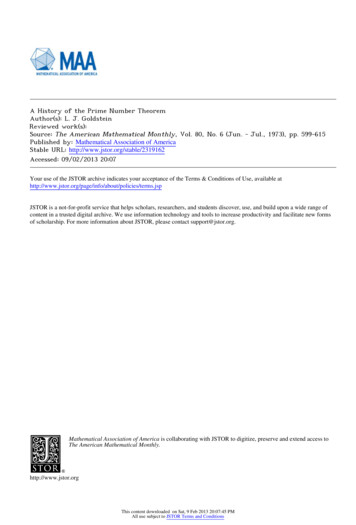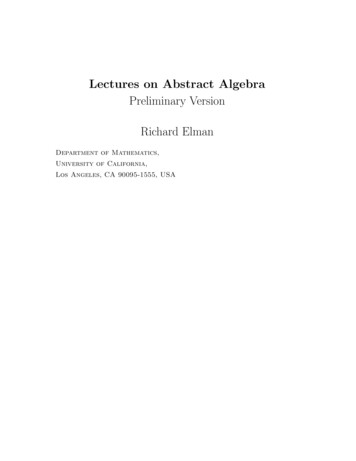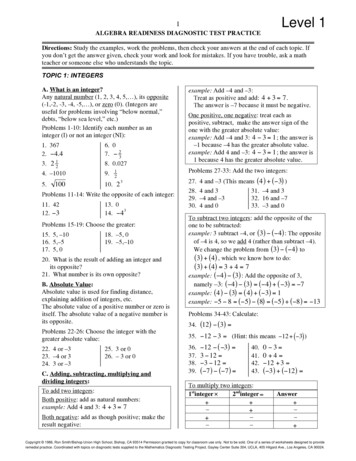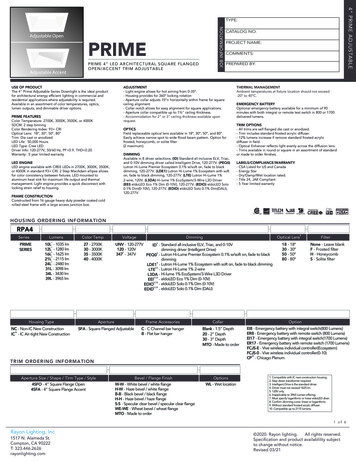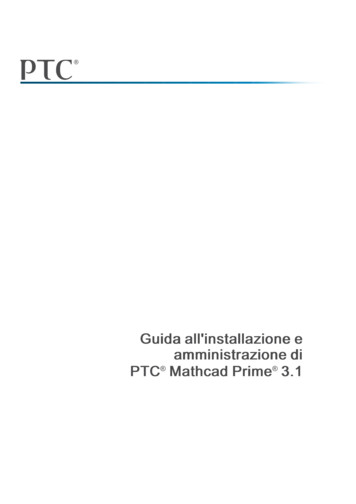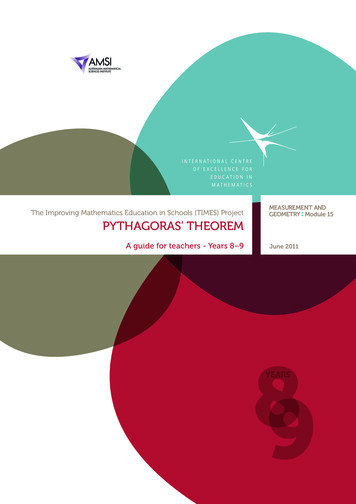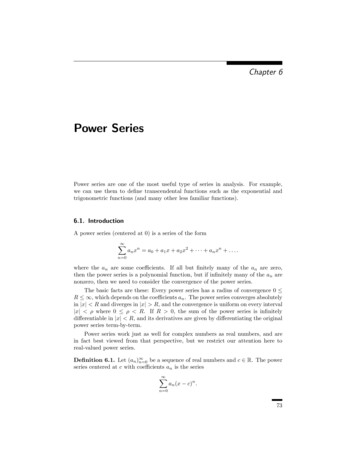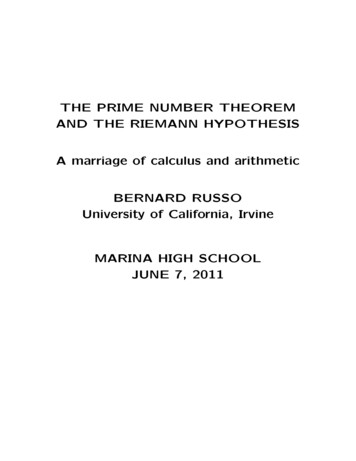
Transcription
THE PRIME NUMBER THEOREMAND THE RIEMANN HYPOTHESISA marriage of calculus and arithmeticBERNARD RUSSOUniversity of California, IrvineMARINA HIGH SCHOOLJUNE 7, 2011
Biographical Sketch—Bernard RussoGraduate Study in MathematicsUCLA 1961-1965Professor of MathematicsUCI 1965-2005Professor Emeritus of MathematicsUCI 2005-presentAssociate SecretaryAmerican Mathematical Society 1998-2002ChairmanDepartment of Mathematics UCI 2001-2004
“book report”“PRIME OBSESSION”
JOHN DERBYSHIRE2003
Prologue Is there a general rule or formula for howmany primes there are less than a givenquantity, that will spare us the trouble ofcounting them? (The Prime Number Theorem PNT, proved in 1896, does this approximately; the Riemann Hypothesis RH,still unproven, does this exactly.) The Riemann Hypothesis is now the greatwhite whale of mathematical research. Theentire twentieth century was bracketed bymathematicians’ preoccupation with it.
Unlike theFour-Color Theorem,orFermat’s Last Theorem,theRiemann Hypothesisis not easy to state in terms a nonmathematician can easily grasp.The four-color problem was stated in 1852and solved in 1976;Fermat’s Last ‘Theorem’ was stated in 1637and solved in 1994;the Riemann Hypothesis was stated in 1859and remains unsolved to this day.
Divergence of the harmonic series1 1/2 1/3 1/4 · · · Proof:(Nicole d’Oresme 1323–1382).1/3 1/4 1/21/5 1/6 1/7 1/8 1/21/9 1/10 · · · 1/16 1/2···(“You can’t beat going to the original sources.”)
The traditional division of mathematics intosubdisciplines:Arithmetic (whole numbers)Geometry (figures)Algebra (abstract symbols)Analysis (limits).The first and last combine to form analyticnumber theory. There are others (and how!)
Analysis dates from the invention of calculusby Newton and Leibnitz in the 1670s.Arithmetic, by contrast with analysis, is widelytaken to be the easiest, most accessible branchof math. Be careful though—it is rather easyto state problems that are ferociously difficultto prove (e.g., Goldbach conjecture, Fermat’sLast ‘Theorem’).
MATHEMATICS SUBJECT CLASSIFICATION(AMERICAN MATHEMATICAL SOCIETY)00-XX General01-XX History and biography03-XX Mathematical logic and foundations05-XX Combinatorics06-XX Lattices, ordered algebraic structures08-XX General algebraic systems11-XX NUMBER THEORY12-XX Field theory and polynomials13-XX Commutative algebra14-XX Algebraic geometry15-XX Linear algebra; matrix theory16-XX Associative rings and algebras17-XX Nonassociative rings and algebras18-XX Category theory; homological algebra19-XX K-theory20-XX Group theory and generalizations22-XX Topological groups, Lie groups26-XX Real functions28-XX Measure and integration30-XX COMPLEX FUNCTION THEORY
31-XX Potential theory32-XX Several complex variables33-XX Special functions34-XX Ordinary differential equations35-XX Partial differential equations37-XX Dynamical systems, ergodic theory39-XX Difference and functional equations40-XX Sequences, series, summability41-XX Approximations and expansions42-XX Harmonic analysis on Euclidean spaces43-XX Abstract harmonic analysis44-XX Integral transforms45-XX Integral equations46-XX Functional analysis47-XX Operator theory49-XX Calculus of variations, optimal control51-XX Geometry52-XX Convex and discrete geometry53-XX Differential geometry54-XX General topology55-XX Algebraic topology57-XX Manifolds and cell complexes58-XX Global analysis, analysis on manifolds
Probability theoryStatisticsNumerical analysisComputer scienceMechanics of particles and systemsMechanics of deformable solidsFluid mechanicsOptics, electromagnetic theoryClassical thermodynamics, heatQuantum theoryStatistical mechanics, matterRelativity and gravitational theoryAstronomy and astrophysicsGeophysicsOperations researchGame theory, economicsBiology and other natural sciencesSystems theory; controlInformation and communicationMathematics education
The Prime Number Theorem Is there a biggest prime? NO (300BCE).(see THEOREMS 4 and 7 in Appendix 1) Whole numbers are to primes what moleculesare to atoms (Fundamental Theorem ofArithmetic) Atoms run out before you getto 100; the primes go on forever.(see THEOREMS 1 and 2 in Appendix 1). Do the primes eventually thin out. Can wefind a rule, a law, to describe the thinningout? There are25 primes between 1 and 10017 between 401 and 50014 between 901 and 10004 between 999,901 and 1,000,000.(see THEOREMS 5 and 8 in Appendix 1) The Prime Counting Function. The number of primes up to a given quantity x isdenoted by π(x) (x need not be a wholenumber).
The Prime Number Theorem states roughlythat: π(N ) behaves very much like N/ log N .(This is the ‘natural logarithm’, to basee 2.718 · · ·, not to base 10.)(see THEOREM 6 in Appendix 1) PNT was conjectured by Gauss at the endof the 18th century, and proved by twomathematicians (independently and simultaneously) at the end of the 19th century,using tools developed by Riemann in themiddle of the 19th century. If the Riemann Hypothesis is true, it wouldlead to an exact formulation of PNT, instead of one that is always off by severalpercent.
On the Shoulders of Giants The greatest mathematician who ever livedwas the first person to whom the truth contained in the PNT occurred—Carl FriedrichGauss (1777-1855).(age 10) 1 2 · · · 100 ?(age 15) Beginning in 1792, at the age of15, Gauss had amused himself by tallyingall the primes in blocks of 1,000 numbersat a time, continuing up into the high hundreds of thousands.
The other first rank mathematical geniusborn in the 18th century—Leonhard Euler(1707-1783)—solved the “Basel problem”and discovered the “Golden Key.”
There is also the ‘Russian connection’: Peter the great established an Academy inSt. Petersburg in 1682 and imported Euler from Switzerland to run it—Russia hadjust come out of a dark period of its development
Riemann’s Zeta FunctionThe Basel problem opens the door to the zeta*function, which is the mathematical object theRiemann Hypothesis is concerned with.The Basel problem (posed in 1689) is: Whatis the exact value of111· · ·?1 4916*Not to be confused with the Catherine ZetaJones function
The answer (Euler 1735): π 2/6.He also showed that1111 · · · π 4/9016812561111 6 6 6 · · · π 6/945234and so forth.In summary, Euler found the exact value of1 1N 1N 1N · · · for every even N 2, 4, 6, . . .234However, to this day, no one knows the exactvalue of this series for any odd value of N ,N 3, 5, 7, . . .Are they irrational? (see Appendix 2 forsome facts about irrational numbers)
Replace the exponent N 2 in the Basel problem by any (for the moment real) number s toget the zeta functionζ(s) Xn s.n 1The series defining the zeta function convergesas long as s 1 (s need not necessarily be awhole number) but it diverges for s 1. Itappears that the zeta function also diverges forany s 1 (since the terms are bigger than thecorresponding terms for s 1) and it behaveslike 1/(s 1) for s 1.Thus, the domain of the zeta function is theset of all (real) numbers greater than 1. Right?WRONG!
WHAT IS EULER’S “GOLDEN KEY”?11ζ(s) 1 s s · · ·231111ζ(s) s s s · · ·2s24611111(1 s )ζ(s) 1 s s s s · · ·2357911(1 s )(1 s )ζ(s) 3211111 1 s s s ··· ······5711s225s1p(1 ps )ζ(s) 1 and thePQgolden key: n n s p(1 p s) 1This leads toQThe golden key is the initial link betweenanalysis (zeta function)) and arithmetic (primes).Hence it could be viewed as the “engagement”of analysis with arithmetic.
Bernhard Riemann’s legacyIn Riemann’s doctoral dissertation, the “Riemann integral” occurs, now taught as a fundamental concept in calculus courses.His habilitation lecture (second doctoral degree) was on the foundations of geometry. Theideas contained in this paper were so advancedthat it was decades before they became fullyaccepted, and 60 years before they found theirnatural physical application, as the mathematical framework for Einstein’s General Theoryof Relativity.
Domain StretchingThe Riemann Hypothesis states: All non-trivialzeros of the zeta function have real partone-half.What is a zero of a function? What are thezeros of the zeta function? When are theynon-trivial. After we answer these questionswe’ll move on to “real part one-half.”A “zero” of a function is a number a such thatthe function has the value zero at a. In otherwords, if you graph the function, its zeros arethe numbers on the x-axis at which the graphof the function crosses the x-axis. A goodexample is the function sin x, which has zerosat x 0, π, π, 2π, 2π, . . .
An infinite series might define only part of afunction; in mathematical terms, an infiniteseries may define a function over only part ofthat function’s domain. The rest of the function might be lurking away somewhere, waitingto be discovered by some trick.EXAMPLE 1: S(x) 1 x x2 x3 · · ·,which converges for 1 x 1 and equals1/(1 x) for those values of x. Since 1/(1 x)makes sense for all numbers except x 1, thisshows that the domain of S(x) is larger than 1 x 1.EXAMPLE 2: The Gamma function and theR t x 1factorial symbol. If you define H(x) 0 e tdt,then one has H(2) 1, H(3) 2, H(4) 6, H(5) 24, . . ., in fact for every positive integer m, H(m) (m 1)! 1 · 2 · 3 · · · · · (m 2)(m 1).
Back to the zeta functionIn addition to arguments greater than 1, thezeta function has values for all arguments lessthan 1. This extension of the zeta function isdone in two steps: first to all arguments between 0 and 1 (by changing signs in the series),and then to all negative arguments (by usinga deep formula in Riemann’s famous 1859 paper).The extended zeta function has the value zeroat every negative even number. These are thetrivial “zeros” of the zeta function.
STEP 1: Define the “eta” function”:η(s) 1 21s 31s 41s · · ·This converges whenever s 0.It is easy to see that for s 1,ζ(s) η(s)11 2s 1Therefore, ζ(s) extends to the positive realaxis.
STEP 2: From Riemann’s 1859 paper, forevery s 0 (except for s 1)ζ(1 s) 21 sπ 1 sin( 1 s2 π)(s 1)!ζ(s)For example ζ( 15) can be calculated fromζ(16)This extends ζ(s) to all values of s 0 andmoreover shows that if m 1, 2, . . .ζ( 2m) 0Thus ζ(s) is defined for all real number exceptfor s 0, 1 and the negative even integers 2, 4, 6, 8, . . .are what are called the “trivial zeros” of thezeta function.
If the Riemann Hypothesis were true, itwould reveal a deep secret about primenumbers which has no foreseeable practicalconsequences that could change the world.In particular, PNT would follow as a consequence. However, RH is much strongerthan PNT, and the latter was proved usingweaker tools. There were several significant landmarksbetween Riemann’s paper in 1859 and theproof of PNT (in 1896). The main significance of Riemann’s paper for the proofof the PNT is that it provided the deepinsights into analytic number theory thatshowed the way to a proof.
If the PNT was the great white whale ofnumber theory in the 19th century, RH wasto take its place in the 20th, and moreoverwas to cast its fascination not only on number theorists, but on mathematicians of allkinds, and even on physicists and philosophers. There is also the neat coincidence of thePNT being first thought of at the end ofone century (Gauss, 1792), then being provedat the end of the next (Hadamard and dela Vallée Poussin, 1896). The attention of mathematicians turned toRH, which occupied them for the followingcentury—which came to its end withoutany proof being arrived at.
By the later 19th century the world of mathematics had passed out of the era whenreally great strides could be made by a single mind working alone. Mathematics hadbecome a collegial enterprise in which thework of even the most brilliant scholars wasbuilt upon, and nourished by, that of livingcolleagues. One recognition of this fact was the establishment of periodic International Congresses of Mathematicians, with PNT amongthe highlights of the first meeting in 1897in Zürich. There was a second Congress inParis in 1900.
The Paris Congress will forever be linkedwith the name of David Hilbert, a German mathematician working at Göttingen,the university of Gauss, Dirichlet, and Riemann, for his address on the mathematicalchallenges of the new century, RH beingthe most prominent among them. Each problem came from some key fieldof mathematics at the time. If they wereto be solved, their solution would advancethat field in new and promising directions.
Nine Zulu Queens Ruled China We know what the trivial zeros of the zetafunction are. What are the non-trivial zeros? For this we need to know about complex numbers. Mathematicians think of numbers as a setof nested Russian dolls. The inhabitants ofeach Russian doll are honorary inhabitantsof the next one out. In N you can’t subtract; in Z you can’tdivide; in Q you can’t take limits; in R youcan’t take the square root of a negativenumber. With the complex numbers C,nothing is impossible. You can even raisea number to a complex power.
Therefore, in the zeta function, the variable s may now be a complex number, andthe Riemann hypothesis now makes sense:it asserts that the non-trivial zeros of thezeta function all lie on the vertical line whosehorizontal coordinate is equal to 1/2. We shall need a complex plane extensionprocess to determine the precise domainof this complex valued zeta function.
Hilbert’s Eighth Problem Since 1896 it was known, with mathematical certainty, that, yes indeed, π(N ) couldbe approximated arbitrary closely by N/ log N .Everyone’s attention now focused on thenature of the approximation—What is theerror term? Riemann did not prove the PNT, but hestrongly suggested it was true, and evensuggested an expression for the error term.That expression involved all the non-trivialzeros of the zeta function. One of the questions left in this talk is:what exactly is the relation between thezeros of the zeta function and the primenumber theorem. This is answered in Derbyshire’s book.
SUMMARY OF WHAT WELEARNEDThere is a mathematical expression thatpredicts roughly how many prime numbersthere are smaller that any number you careto name. You know also that this prediction, by Gauss, is not entirely accurate, andthat the amount by which it is wrong is thesubject of another mathematical expression, devised by the German mathematician Bernhard Riemann. With Gauss’s estimate, proved independently by two othermathematicians in 1896, and Riemann’scorrection, conjectured but not yet provedby anyone, we know much more about howthe prime numbers are distributed. At theheart of Riemann’s correction factor, andessential to understanding how it is relatedto prime numbers, is Riemann’s zeta function, and in particular, a series of numberswhich are known as the Riemann zeros.
APPENDIX 1—PRIME NUMBERSTHEOREM 1—FUNDAMENTALTHEOREM OF ARITHMETIC(PART I—EXISTENCE)Every positive integer (other than 1) is either a prime or a product of primes.PROOF:Let Let n 2 be an any integer. If nis a prime, there is nothing to prove. Ifn is not a prime it has a divisor differentfrom itself and from 1. If m is the smallest such divisor, then m must be a prime.Let’s call it p1 and write n p1n1 for someinteger n1 with n1 n. Repeat this argument starting with n1. Either n1 is aprime, in which case we are done, or ithas a prime factor p2 and there is an integer n2 n1 with n1 p2n2. We nowhave n p1p2n2. Continuing this processwe obtain a sequence of primes p1, . . . , pk ,and a sequence of integers nk nk 1 · · · n1 n, with n p1p2 · · · pk nk . Since1 nk nk 1 · · · n1 n, at somepoint, nk must be a prime. This completesthe proof.
THEOREM 2—FUNDAMENTALTHEOREM OF ARITHMETIC(PART II-UNIQUENESS)Every positive integer is a product of primesin only one way.PROOF:If there were numbers with two distinctprime factorizations, let n be the smallestsuch number. If P is any prime number,then P cannot appear in both factorizations of n—if it did, then n/P , which issmaller than n would have two distinct factorizations. So we have n p1p2 · · · pk q1, q2 · · · qm where no prime pj is the sameas any of the primes qi. We may assumethat p1 is the smallest pj and q1 is thesmallest qi. Since n is composite, p21 nand q12 n. Since p1 6 q1, we must havep1q1 n. Set N n p1q1. Now notethat N has a unique factorization since itis smaller than n, and N is divisible by p1and q1. Since N has a unique factorization,it is also divisible by p1q1. But we also can
write n N p1q1 so that n is also divisible by p1q1. This is the same as sayingthat q1 divides n/p1. But n/p1 p2 · · · pkis less than n and so it has a unique primefactorization and it follows that q1 must beone of p2, . . . , pk . This is a contradiction,completing the proof.THEOREM 3If a prime divides a product of two numbers, then it must divide one of the numbers (PROOF NOT GIVEN)THEOREM 4There is no largest prime number.PROOF:Let p be any prime and consider the number Q which is one more than the productof all primes up to p: Q 2 · 3 · 5 · · · · · p 1.Then Q is not divisible by any of the primesup to p, so it is either a prime itself, or it isdivisible by a prime, larger than p, In eithercase, there is a prime larger than the givenp. The theorem is proved.
THEOREM 5There are blocks of arbitrary length of composite numbers.PROOF:As in the proof of THEOREM 4, let pbe any prime and note that ALL numbers2, 3, 4, . . . , p 1, p are divisible by at leastone prime up to p. Now define Q to bethe product of all primes up to p: Q 2 · 3 · 5 · · · · · p (we don’t add one this time).Then the following p 1 numbers are allcomposite, proving the theorem: Q 2, Q 3, Q 4, . . . , Q p.THEOREM 6 (PNT)limx x/π(x) 1 (NO PROOF GIVEN)log xTHEOREM 7P 1 diverges (NO PROOF GIVEN)n 1 pnTHEOREM 8There is a prime number between n and 2nfor every n 1, 2, . . . (NO PROOF GIVEN)
APPENDIX 2—IRRATIONAL NUMBERSTHEOREM 9 2 is irrationalPROOF: Suppose that 2 a/b where a/b is a fraction in lowest terms. Since 2b2 a2, it follows that a2 is even, and hence a is even,say a 2c. Then 2b2 (2c)2 4c2 sothat b2 2c2 is even, and so is b. Thiscontradicts the fact that a/b was in lowestterms, and proves the theorem.THEOREM 10 N is irrational unless N is a perfect square(NO PROOF GIVEN)THEOREM 11N 1/m is irrational unless N am for someinteger a (NO PROOF GIVEN)THEOREM 12If xm c1xm 1 · · · cm 0 and c1, c2, . . . , cmare integers then x is irrational, unless it isan integer. (NO PROOF GIVEN)
THEOREM 13log10 2 is irrationalPROOF:Let us suppose that log10 2 a/b. This isthe same as 10a/b 2, equivalently, 10a 2b, or 2a5a 2b. By the uniqueness in thefundamental theorem of arithmetic (Theorem 2), we must have, in particular, a 0,which is a contradiction since log10 2 6 0,This proves the theorem.THEOREM 14logn m is irrational if one of m and n has aprime factor which the other lacks.(NO PROOF GIVEN)THEOREM 15e is irrationalPROOF:Suppose that e were rational, say e a/b.Let k be any integer b. Define the number t to be 111t k! e 1 ··· 1! 2!k!
Thusa111t k! 1 ··· b1! 2!k!and so it is clear that t is a positive integer.But if you use the series for the number e,you find that t 1, which is a contradiction. We have !11 ···(k 1)!(k 2)!11 ···k 1(k 1)(k 2)11 ···2k 1(k 1)!111 1 ···k 1k 1(k 1)2t k! 1 11 1,1k 1 1 k 1kas was stated. Thus e is irrational.
“book report” “PRIME OBSESSION” . proximately; the Riemann Hypothesis RH, still unproven, does this exactly.) The Riemann Hypothesis is now the great white whale of mathematical research. The entire twentieth century was bracketed by . (1 s) 21 sπ


